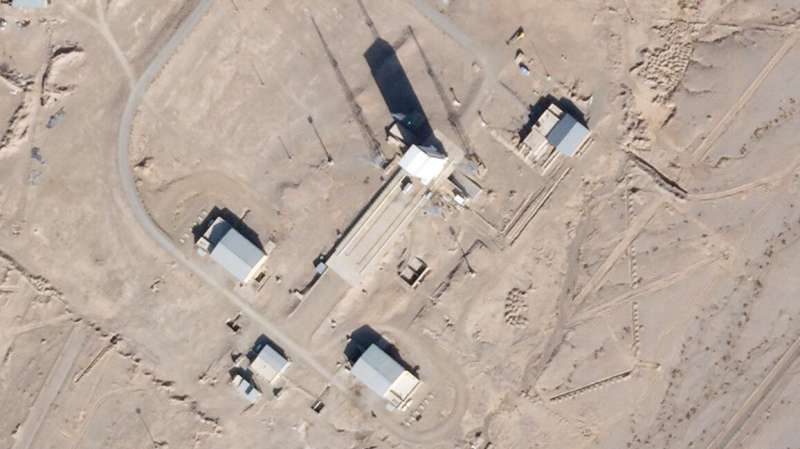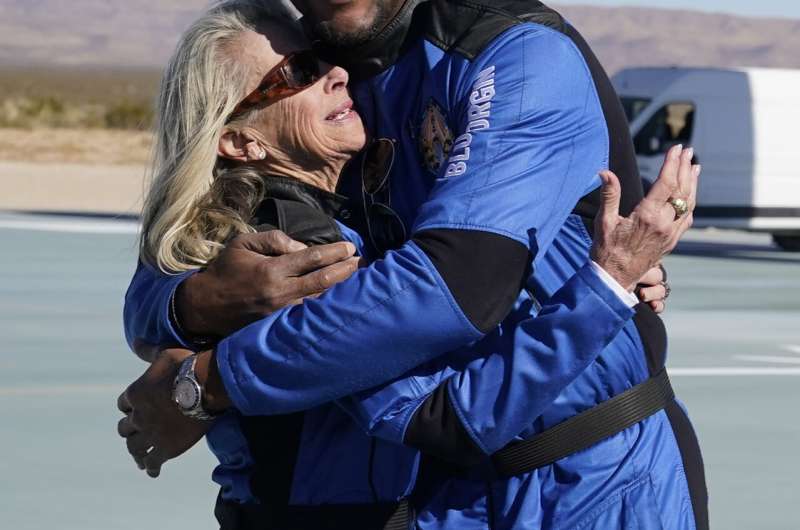
Copernical Team
Out now: the December quarterly ESA Impact

ESA Impact 2021 Q4 edition
Great images and videos of climate change on view, BepiColombo flies by Mercury, Cheops gets a surprise, and more
Satellite images, expert suggest Iranian space launch coming

Strahan flies to space with astronaut's daughter: 'Wow!'

Football star and TV celebrity Michael Strahan caught a ride to space with Jeff Bezos' rocket-launching company Saturday, sharing the trip with the daughter of America's first astronaut.
"TOUCHDOWN has a new meaning now!!!" he tweeted after landing.
Blue Origin's New Shepard rocket blasted off from West Texas, sending the capsule on a 10-minute flight with the two VIP guests and four paying customers.
Iron integral to the development of life on Earth - and the possibility of life on other planets
 Iron is an essential nutrient that almost all life requires to grow and thrive. Iron's importance goes all the way back to the formation of the planet Earth, where the amount of iron in the Earth's rocky mantle was 'set' by the conditions under which the planet formed and went on to have major ramifications for how life developed.
Now, scientists at the University of Oxford have uncovered
Iron is an essential nutrient that almost all life requires to grow and thrive. Iron's importance goes all the way back to the formation of the planet Earth, where the amount of iron in the Earth's rocky mantle was 'set' by the conditions under which the planet formed and went on to have major ramifications for how life developed.
Now, scientists at the University of Oxford have uncovered Gas bubbles in rock pores - a nursery for life on Early Earth
 Where and how did life begin on Early Earth more than 3.5 billion years ago from non-living chemicals? Discovering the answer to this question has long been debated and is a challenge for scientists. One thing that scientists can look for is potential environments that allowed life to spark. A key necessity for the first cells on Earth is the ability to make compartments and evolve to facilitate
Where and how did life begin on Early Earth more than 3.5 billion years ago from non-living chemicals? Discovering the answer to this question has long been debated and is a challenge for scientists. One thing that scientists can look for is potential environments that allowed life to spark. A key necessity for the first cells on Earth is the ability to make compartments and evolve to facilitate The uneven universe
 It is almost always assumed in cosmological calculations that there is a even distribution of matter in the universe. This is because the calculations would be much too complicated if the position of every single star were to be included. In reality, the universe is not uniform: in some places there are stars and planets, in others there is just a void.
Physicists Michael te Vrugt and Prof
It is almost always assumed in cosmological calculations that there is a even distribution of matter in the universe. This is because the calculations would be much too complicated if the position of every single star were to be included. In reality, the universe is not uniform: in some places there are stars and planets, in others there is just a void.
Physicists Michael te Vrugt and Prof Airbus and DLR intensify cooperation
 Airbus and the German Aerospace Center are expanding their cooperation in research on climate protection in aviation. Under an agreement signed by Nicole Dreyer-Langlet, Airbus' VP Research and Technology Representative, Germany, and Markus Fischer, DLR Divisional Board Member Aeronautics, future joint projects will focus, in particular, on emission measurements for new types of aviation fuels,
Airbus and the German Aerospace Center are expanding their cooperation in research on climate protection in aviation. Under an agreement signed by Nicole Dreyer-Langlet, Airbus' VP Research and Technology Representative, Germany, and Markus Fischer, DLR Divisional Board Member Aeronautics, future joint projects will focus, in particular, on emission measurements for new types of aviation fuels, High-tech sleeping bag could solve vision issues in space
 A subtle smile emerged on Dr. James Leidner's face as he envisioned telling people of the unusual contribution he made to mankind's mission to Mars.
For 72 straight hours, the study volunteer lay in a bed at UT Southwestern, the monotony broken only at night when researchers placed his lower body in a sealed, vacuum-equipped sleeping bag to pull down body fluids that naturally flowed int
A subtle smile emerged on Dr. James Leidner's face as he envisioned telling people of the unusual contribution he made to mankind's mission to Mars.
For 72 straight hours, the study volunteer lay in a bed at UT Southwestern, the monotony broken only at night when researchers placed his lower body in a sealed, vacuum-equipped sleeping bag to pull down body fluids that naturally flowed int Bezos' Blue Origin completes third crewed space flight

Jeff Bezos' Blue Origin company blasted its third private crew into space on Saturday and brought it back safely, this time including the daughter of the first American astronaut.
The stubby white spacecraft with a round tip blasted off into clear blue skies over West Texas for a roughly 11-minute trip to just beyond the internationally recognized boundary of space, 62 miles (100 kilometers) high.
The six-member crew hooted with glee as they unbuckled to enjoy a few minutes of weightlessness, looking out at space through tall windows in the capsule.
"I've never seen anything like that," one unidentified crew member said as Blue Origin livestreamed the flight.
Daughter of first American astronaut launches on Blue Origin flight
 Jeff Bezos' Blue Origin company blasted its third private crew to space on Saturday, this time including the daughter of the first American astronaut.
The stubby white spacecraft with a round tip blasted off into clear blue skies over West Texas for a roughly 11 minute trip to just beyond the internationally-recognized boundary of space, 62 miles (100 kilometers) high.
The six-member cre
Jeff Bezos' Blue Origin company blasted its third private crew to space on Saturday, this time including the daughter of the first American astronaut.
The stubby white spacecraft with a round tip blasted off into clear blue skies over West Texas for a roughly 11 minute trip to just beyond the internationally-recognized boundary of space, 62 miles (100 kilometers) high.
The six-member cre 